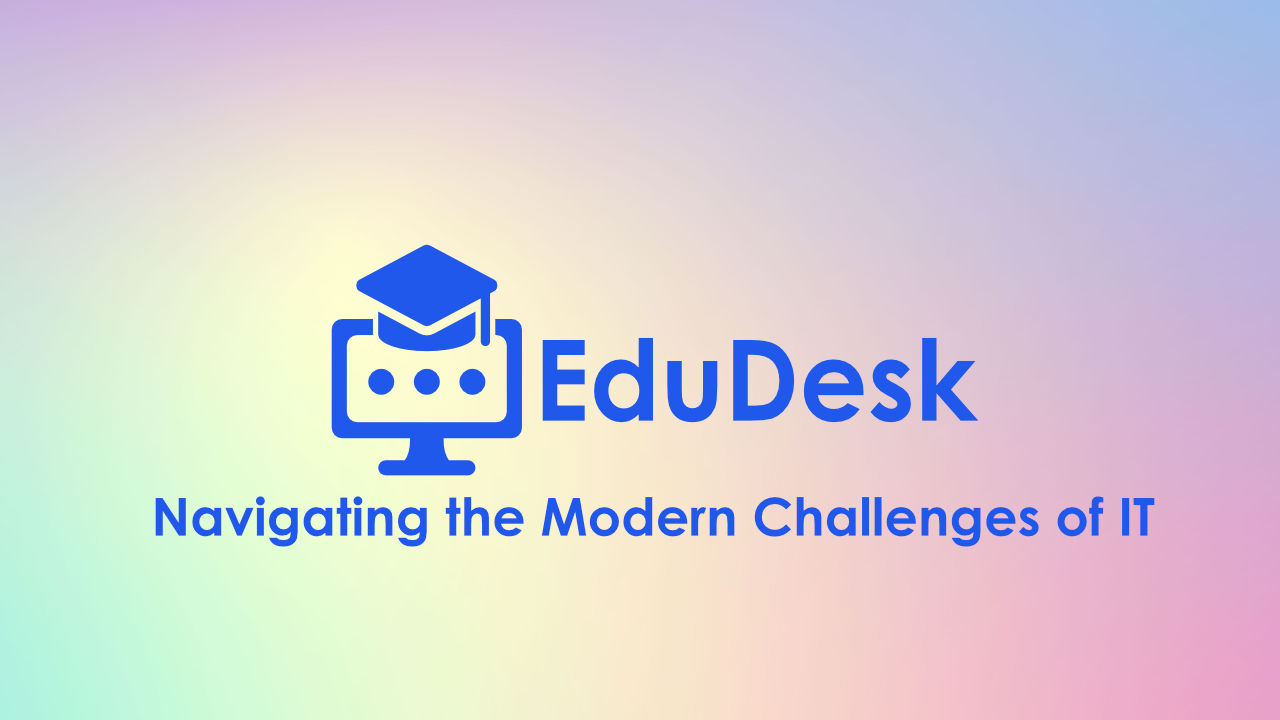Navigating the Modern Challenges of IT: Trends, Risks, and Smarter Solutions
Introduction: When Technology Becomes a Roadblock Instead of a Bridge
In today’s classrooms, technology isn’t a luxury — it’s the backbone of learning. Chromebooks, interactive whiteboards, LMS platforms, and cloud-based tools have transformed how educators teach and how students learn. But there’s a catch: when IT systems break down or support processes stall, the learning experience grinds to a halt.
Ask any school IT administrator about the start of the school year, and you’ll likely hear stories about hundreds of password resets, device issues piling up, and tickets vanishing into a black hole of email threads. It’s not just frustrating — it’s a real threat to operational efficiency, teacher morale, and ultimately student success.
This post explores some of the biggest challenges educational IT teams face today, how to address them, and where platforms like EduDesk fit into a more proactive, modern approach.
1. The Growing Complexity of School Technology
Educational IT teams now manage far more than a few lab desktops and a printer. Devices are spread across classrooms, libraries, and student homes. Systems must integrate with cloud services, SIS (Student Information Systems), and security platforms — often from multiple vendors.
The Challenge
- Device sprawl: One middle school can easily have 1,000+ Chromebooks in circulation.
- Integration overload: A single teacher might use five different digital platforms in one lesson.
- Security pressures: Schools face ransomware threats and compliance requirements (FERPA, CIPA).
Without clear tracking and workflow systems, administrators spend more time chasing device histories and troubleshooting guesswork than resolving issues.
The Smarter Approach
Adopting a centralized IT management hub is becoming essential. Solutions should offer:
- Unified ticketing and asset tracking
- Role-based access to ensure data privacy
- Integration with existing tools (Google Admin Console, SIS platforms)
EduDesk, for example, was designed specifically for K–12 workflows, combining ticketing, knowledge base, and asset management into one interface — meaning fewer logins, fewer gaps, and more time fixing problems instead of finding them.
2. The Bottleneck of Outdated Ticketing Systems
For many schools, reporting an IT issue still involves sending an email, filling out a clunky web form, or — in some cases — scribbling a note on paper. These methods are slow, prone to getting lost, and don’t give teachers any visibility into the resolution process.
Real-World Scenario
Imagine a teacher’s projector stops working before a major presentation. They email IT, but that request gets buried under a flood of unrelated emails. A week later, the issue is still unresolved, the teacher has improvised lessons, and the equipment is still broken.
The Smarter Approach
Modern help desk systems built for education:
- Allow ticket submission in seconds (with images and device tags)
- Provide real-time status updates so staff know when help is coming
- Use smart routing to get tickets to the right tech faster
EduDesk’s Tickets module, for instance, eliminates the black hole effect by letting staff submit tickets in seconds and track them in real time. Teachers know exactly when help is on the way, and IT can prioritize based on urgency.
3. Knowledge Gaps That Slow Down Resolution
Many tickets schools receive are repetitive: Wi-Fi connection issues, printing problems, password resets. These eat up valuable IT time that could be spent on larger projects or preventative maintenance.
The Challenge
Without a centralized knowledge base, every small question becomes an email or a ticket. This creates bottlenecks and burns out IT staff.
The Smarter Approach
Providing staff with self-service tools cuts down on repetitive requests. Best practices include:
- Building an internal knowledge base for common fixes
- Linking help articles directly from the ticket submission page
- Regularly updating content as new issues emerge
EduDesk’s Docs module (live today) links self-help resources directly to the ticket form, helping staff solve problems themselves and reducing support volume — without compromising quality.
4. Data-Driven Decision Making for IT in Education
School IT departments are often stretched thin, making it difficult to track long-term trends. Without reporting tools, it’s hard to know:
- Which devices fail most often
- Which departments generate the most support requests
- How response times are improving (or not)
Real-World Impact
If a district notices that 70% of tickets over a semester involve one specific Chromebook model, they can make informed purchasing decisions and avoid future downtime.
The Smarter Approach
Modern IT platforms include:
- Advanced reporting and analytics
- Category and trend tracking for smarter budgeting
- Integration with asset management for lifecycle planning
EduDesk’s reporting tools, for example, give administrators visibility into trends, bottlenecks, and recurring issues — data that’s invaluable for both IT planning and budget proposals.
5. Preparing for the Future: AI and Automation in School IT
As budgets tighten, AI and automation offer new ways to maintain service quality without overextending IT teams.
The Opportunities
- Automated ticket routing to the right technician
- AI-powered troubleshooting that solves issues before they’re reported
- Predictive analytics to anticipate hardware failures
EduDesk’s Scholar AI is an early example of this trend, trained specifically on real school IT problems. It helps resolve issues before they become tickets, freeing up technicians for more complex work.
Conclusion: Smarter IT Means Stronger Schools
Educational technology is only as good as the systems that support it. Outdated ticketing, scattered asset tracking, and reactive-only troubleshooting drain resources and frustrate staff. By adopting modern, education-focused IT platforms, schools can move from putting out fires to proactively improving operations.
Whether you choose EduDesk or another modern IT solution, the takeaway is clear: Centralization, visibility, and proactive support are no longer optional — they’re the new baseline for educational IT success.
If you’re exploring smarter IT workflows for your school or district, it’s worth looking into platforms like EduDesk that are built from the ground up for education’s unique challenges.

